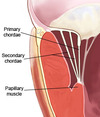Lab 3 Flashcards
(73 cards)
Fornix
- Is an arching, fibrous band of nerve fibers that extend from the hippocampus to the mamillary body of the hypothalamus
- An archlike anatomical structure or fold, such as the arched band of white matter located beneath the corpus callosum of the brain.
Septum Pellucidum

A thin membrane of nervous tissue that forms the medial wall of the lateral ventricles in the brain

Development of the the neural tube from embryonic ectoderm
1) The neural plate forms from surface ectoderm.
2) the Neural plate invaginates, forming the neural groove flanked by neural folds.
3) Neural fold cells migrate, form the nural crest, will form much of the PNS and other surfaces.
4) the Neural groove becomes the neural tube, which will form CNS structures.
Gray matter
Neuron cell body clusters
White matter
Nerve fibers = (myelinated axons)
Basal Nuclei (def. location, function)
- Are densely packed locations of cell bodies (somas) in the subcortical area (beneath the cortex) of the brain. Gray matter
- Nuclear bodies are in the CNS.
- Important in starting, stopping, and monitoring the intensity of movements executed by the cortex
Basal Ganglia (def. location)
- Are the cluster of neuron cell bodies and dentrites.
- Located in the PNS. Ex. the dorsal root ganglions that exit each vertabrae at the intervertebral foramen
Brain function
Sensory — Integration —– Motor
4 Major parts of the brain
- Brain stem (medulla oblongata, pons, midbrain)
- Diencephalon (thalamus, hypothalamus)
- Cerebrum (83% of brain mass)
- Cerebellum (little brain)
Major lobes of cerbrum
- Frontal lobe (1)
- Parietal lobes (2)
- Temporal Lobes (2)
- Occipital lobe (1)
- Insula
Gustatory cortex (taste) location
In Insula
Specific sulci / fissures
- Central sulcus
- Lateral / Sylvian sulcus
- Transverse fissure
- Longitudinal fissure
Extensions of Dura Matter
- Tentorium cerebelli (separartes occipital lobe from cerebellum)
- Falx cerbelli (separates cerebellar hemispheres)
- Falx cerebri (separates the 2 hemispheres of the brain)
Connetion of the 2 hemispheres
Corpus callosum
Outer cortex of brain (compossition and characteristics)
- Gray matter surrounds an interior that is mostly white matter, except for a few small protions (basal nuclei)
- Surface is marked by ridges called gyri separated by grooves called sulci
Cerebrum divisions
internally each hemispheres is divided into 3 regions.
- Superficial cortex of gray matter
- Cerebral cortex - outermost layer of gray matter
- Makes up superficial area and functional areas
- Contains 70% of the neurons in CNS
- Internal white matter
- Basal nuclei (islands of gray matter deep within the white matter)
Cerebral cortex functions
- Sensory: allow for conscious recognition of stimuli
- Motor: Control voluntary, motor functions
- Association: integration
Broca’s area
- Region of the brain that contains motor neurons involved in the control of speech.
- This area, located in the frontal part of the left hemisphere of the brain,
Wernicke’s area
- Region of the brain that contains motor neurons involved in the comprehension of speech.
- The Wernicke area is located in the posterior third of the upper temporal convolution of the left hemisphere of the brain.
- Damage to the temporal lobe may result in a language disorder known as Wernicke aphasia.
- An individual with Wernicke aphasia has difficulty understanding language; speech is typically fluent but is empty of content and characterized by circumlocutions, a high incidence of vague words like “thing,” and sometimes neologisms and senseless “word salad.”
Commisural fibers
- Connect corresponding gray areas of the two hemispheres, enabling them to function as a coordinate whole (includes the copus callosum)
- Connect corresponding gray areas of the two hemispheres, enabling them to function as a coordinate whole (includes the copus callosum)
Commisural fibers
Association fibers
- Connect different parts of the same hemisphere
Projection fibers
- Nerve fibers that connect the cerebral cortex with the subcortical centers, the brain stem, and the spinal cord’
Reversed
- Connect different parts of the same hemisphere
Association fibers



















